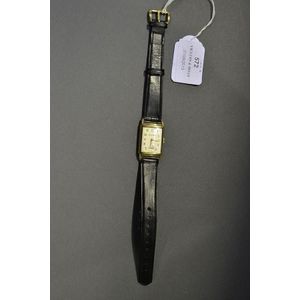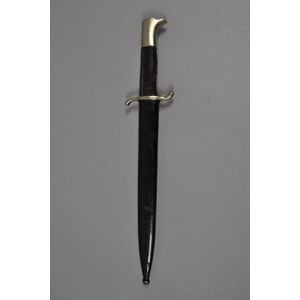Naval Officer's Hangar with Irish Iconography, 1782-90
A naval officers Hangar circa 1782-90 with a slightly curved blade formed with a clippedback point, cut with a pair of long fullers on each face, etched and gilt with trophies, foliage, naval motifs and the inscriptions 'le ville de Paris le 12 avril 1782 ánd 'sandwich le 1782'on a blued panel over the greater part of its surface on both faces (areas of oxidation) gilt-brass slotted hilt, lion head pommel, and the grip bound with copper wire and rib band 62 cm; 24 3/8 blade. The blade of this hangar is probably of German origin. The date 'le 12 Avril 1782' refers to the conclusion of the four-day naval battle between the Caribbean islands of Dominica and Guadeloupe. The victorious fleet being the British, commanded by Admiral Sir George Rodney Kb, who removed the threat of the French to Jamaica, the latter fleet being commanded by Admiral le Comte de Grasse. The extensive Irish iconography on the blade suggests a commission from an Irish officer of the Royal Navy. An officer who had a connection with both ships and with the battle was William Charles Fahie, later Vice Admiral Sir William Charles Fahie KCB (1763-1833) who served on HMS Sandwich 1779-80 was a lieutenant aboard HMS Russell at the Battle of the Saintes and who served briefly aboard the captured Ville De Paris from April to August 1782. HMS Sandwich had been Rodney's flagship 1779- 81 but was not present at the Saintes and Ville De Paris was De Grasse's flagship at the battle. An alternative explanation for the iconography might be that the blade was commissioned by an Irish sword cutler, the selection of HMS Sandwich as representing the British fleet being a random one on the part of the blade-maker. This important sword was purchased at the Thomas Del Mar Ltd (London) sale of 27th June 2012 for 2,600 pounds (with a copy of the catalogue)
You must be a subscriber, and be logged in to view price and dealer details.
Subscribe Now to view actual auction price for this item
When you subscribe, you have the option of setting the currency in which to display prices to $Au, $US, $NZ or Stg.
This item has been sold, and the description, image and price are for reference purposes only.
- Circa - A Latin term meaning 'about', often used in the antique trade to give an approximate date for the piece, usually considered to be five years on either side of the circa year. Thus, circa 1900 means the piece was made about 1900, probably between 1895 and 1905. The expression is sometimes abbreviated to c.1900.
This item has been included into following indexes:
- edged weapons, other - hanger / hangar 31
-
edged weapons, swords
- swords, French 88
- swords, German 58
Visually similar items

Vintage 14ct yellow gold retractable pencil, with bloodstone finial. Test confirms 14ct sleeve, with copper internal operating section, weight 12grams (total).
Sold by
in
for
You can display prices in $Au, $US, $NZ or Stg.

A Christofle silver-plate cake knife with stainless steel blade
Sold by
in
for
You can display prices in $Au, $US, $NZ or Stg.

Sold by
in
for
You can display prices in $Au, $US, $NZ or Stg.

World War II period German Fire Brigade dress bayonet with scabbard in exceptional condition
Sold by
in
for
You can display prices in $Au, $US, $NZ or Stg.
